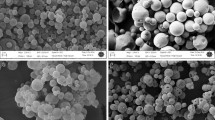Abstract
Purpose. The purpose of this study was to investigate the process of preparing microspheres for maximising entrapment efficiency (EE) and retained biological activity (RBA) of peptides and proteins.
Methods. A controlled-release formulation based on poly(d,l-lactide-co-glycolide) was designed and produced using a small-scale double emulsion method. These PLG microspheres contained a model peptide, lysozyme. The retained bioactivity of the incorporated lysozyme was determined by bacterial assay. The size distributions and the morphology of the microspheres were characterized.
Results. The RBA and EE improved when the PLG concentration in the organic phase of the emulsion was increased. A high lysozyme concentration in the inner water phase of the emulsion resulted in decreased EE and an increase in the proportion of fragmented particles. The RBA of lysozyme in the microspheres varied between 30 and 80% with changes to the process.
Conclusions. The study shows that the RBA of lysozyme in PLG microspheres is strongly dependent on the experimental conditions for preparing the microspheres. Measurement of the EE alone, without the RBA is insufficient to evaluate the efficacy of the designed delivery system.
Similar content being viewed by others
REFERENCES
F. J. T. Fildes, F. G. Hutchinson, and B. J. A. Furr. The development of zoladex—a case history. In R. C. Hider and D. Barlow (eds.), Polypeptides and protein drugs Ellis Horwood, New York, 1991, pp. 228–250.
F. G. Hutchinson and B. J. A. Furr. J. Controlled Release 13:279–294 (1990).
R. Jalil and J. R. Nixon. J. Microencapsulation 3:297–325 (1990).
C. Holden. Science 248:964 (1990).
S. Sameena and D. T. O'Hagan. Int. J. Pharm. 115:259–263 (1995).
K. E. Avis, H. L. Lieberman, and L. Lachman, Chapter 7: Parenteral products of peptides and proteins. In J. W. Yu-Chang (ed.). Pharmaceutical dosage forms: Parenteral medication, volume 1, Marcel Dekker, 1992, pp. 283–319.
J. D. Duncan, P. X. Wang, C. M. Harrington, D. P. Schafter, Y. Matsuoka, J. F. Mestecky, R. W. Compans, and M. J. Novak. J. Controlled Release 41:237–247 (1996).
Y. Tabata, S. Gutta, and R. Langer. Pharm. Res. 10:487–496 (1993).
R. Ghaderi, C. Sturesson, and J. Carlfors. Int. J. Pharm. 141:205–216 (1996).
I. Verhamme, J. Storck, L. Racchelli, and A. Lauwers. Int. Pharmacy J. 2:168–171 (1988).
L. Stryer. Biochemistry. Chapter 9, Mechanisms of enzyme action, Freeman, New York, 1988, pp. 201–211.
C. Yan, J. H. Resau, J. Hewetson, M. West, W. L. Rill, and M. Kende. J. Controlled Release 32:231–241 (1994).
A. C. Albertsson, J. Carlfors, and C. Sturesson. J. Appl. Polym. Sci. 62:695–705 (1996).
E. Mathiowitz, A. Ph. D. Carmela, and R. Langer. Polymer 31:547–555 (1990).
Author information
Authors and Affiliations
Corresponding author
Rights and permissions
About this article
Cite this article
Ghaderi, R., Carlfors, J. Biological Activity of Lysozyme After Entrapment in Poly (d,l-lactide-co-glycolide)-Microspheres. Pharm Res 14, 1556–1562 (1997). https://doi.org/10.1023/A:1012122200381
Issue Date:
DOI: https://doi.org/10.1023/A:1012122200381




